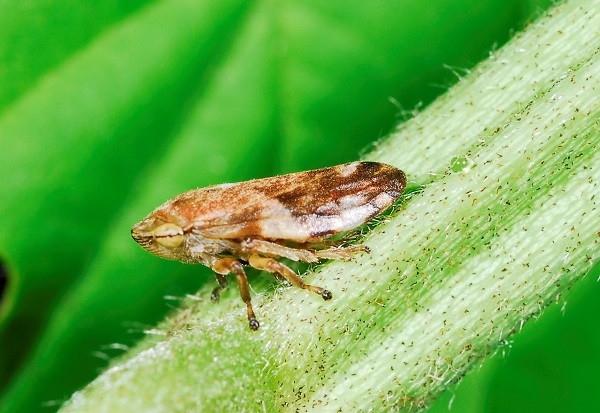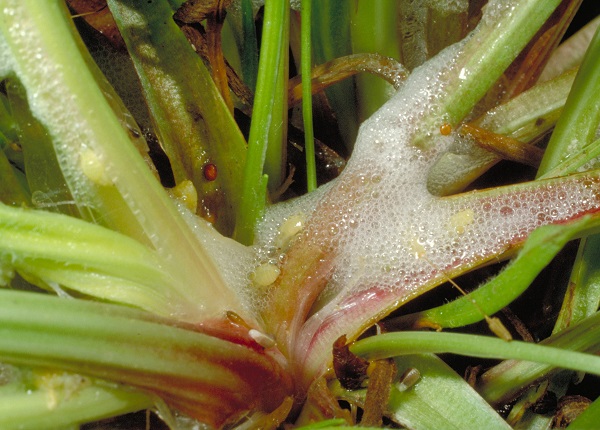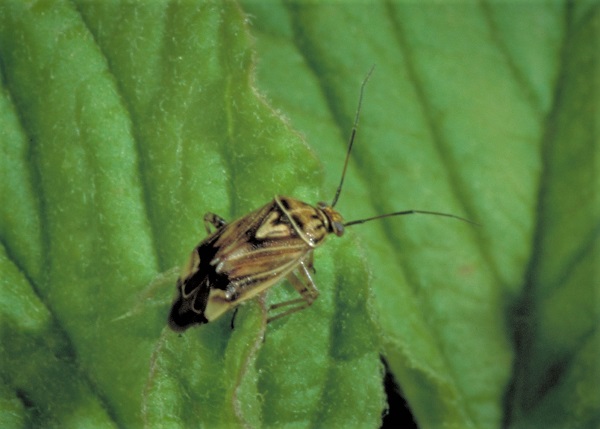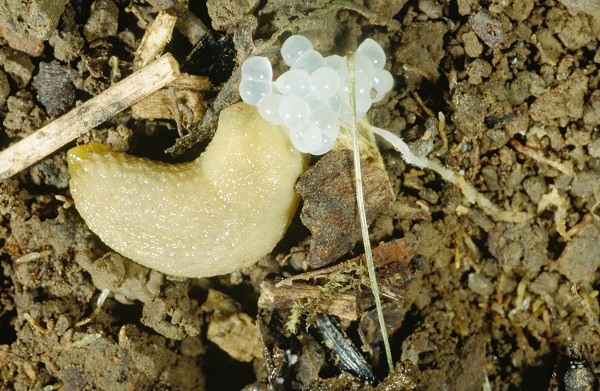Common Strawberry Pests
ENTFACT-207: Common Strawberry Pests | Download PDF
by Ric Bessin, Extension Specialist
University of Kentucky College of Agriculture
Strawberry Root Weevils
Several species of root weevils feed on the young roots and crowns of strawberry plants. Although adults will eat notches in the leaves, this damage is unimportant. However, the grubs of these weevils can cause serious damage by tunneling in roots and crowns of plants. Damaged plants are stunted and darkened with leaves closely bunched. Plants may be weakened or even killed. Often the damage is restricted to a circular area in field due to the tendency of adults to gather in large groups.
The adult stage of these insects is a small, dark snout beetle with rows of pits along their backs. The different species will differ slightly in size and color. The strawberry root weevil is black to light brown and 1/5 inch, the rough strawberry weevil chocolate brown and 1/4 inch, and the black vine weevil is black with small flecks of yellow on its back and 2/5 inch. The grubs are white, 1/4 to 1/2 inch long, and a characteristic "c" shape. These grubs can be distinguished from other soil grubs because they are smaller and legless with a lighter colored head.
Root weevils overwinter in the soil as grubs that pupate in the spring. Adult beetles emerge in late May through June, feed at night on foliage leaving characteristic leaf notching, and hide during the day. After feeding for as short as 10 to 14 days (strawberry root weevil) to as long as 30 to 60 days (black vine weevil) they begin laying eggs in soil near strawberry plants. The eggs hatch in late summer or early fall and the grubs start feeding on the roots. Most damage is caused by grubs after resuming feeding in the spring.
To prevent spread of root weevils to new beds, plow under old beds as soon as possible. Post-harvest foliar sprays to control adult weevils prior to egg laying is recommended at renovation. Growers should watch for leaf notching as an indication of adult emergence.

Figure 1. An adult spittlebug.
Meadow Spittlebug
The meadow spittlebug is an annoying pest on strawberries that can stunt plants and reduce berry size. More important to some producers, particularly u-pick growers, is the annoyance that spittle masses cause pickers. Although the spittle is harmless, pickers object to being wetted by the insect excretion.
Spittlebugs can be recognized by the white masses of wet foam or spittle on leaves, petioles, and stems. The tiny green nymphs produce the spittle covering to protect themselves from predators and desiccation.
Newly emerged adults are bright green and darken to a dull brown. Nymphs feed for five to eight weeks before entering the adult stage. Adults are seen on foliage from late May until frost, but usually go unnoticed because they produce no spittle. Adults lay their eggs in the stems and leaves of plants from July through October. There is only one generation per year.

Figure 2. Spittle bug nymphs produce large amounts of spittle.
Initially the nymphs feed at the base of the plants, but later move up to the tender foliage. Feeding may cause leaves to become wrinkled and dark-green. While fruit may be stunted, significant yield loss seldom occurs. High spittlebug populations are often associated with weedy fields, so proper weed control along with other practices encouraging healthy plants are important.
Prebloom sprays are rarely necessary for spittlebugs, but u-pick growers should keep populations less than one spittle mass per square foot through prebloom to appease customers. Begin estimating spittlebug density at 10% bloom by inspecting five to ten 1-square-foot areas per acre of strawberries at two week intervals. It will be necessary to spread plants and inspect the crowns as well as leaves and stems. Control is considered at one spittlebug per square foot (u-pick) up to four to five per square foot.
Tarnished Plant Bug
Tarnished plant bug is a common sap-feeding insect attacking a wide range of economically important plants. The tarnished plant bug can cause considerable damage to strawberries by puncturing young fruits before receptacles expand. These damaged areas do not develop along with the rest of the berry, resulting in misshapen "cat-faced" fruit. The damage may range from slight deformation to complete loss of market value of the crop.

Figure 3. Tarnished plant bug adults are recognized by the light Y mark behind the head.
The tarnished plant bug overwinters as an adult in leaf debris and other protected areas. Adults are recognized by their greenish-brown body marked with yellowish and black dashes with a characteristic small yellow-tipped triangle behind the head.
Adults become active in April and begin egg laying in weeds. The tiny nymphs are slender, pale green insects that resemble aphids. However, aphids have a pair of cornicles (tail pipe-like tubes on top of their abdomen) and tarnished plant bugs do not. The nymphs turn brown during the last instar. The entire life cycle is completed in 30-40 days with two to four overlapping generations occurring each year.
Most damage takes place just after petal fall. Early June bearing varieties can escape most tarnished plant bug injury because pest populations are small and consist of less damaging early instars. Late maturing cultivars are more susceptible to damage. Plantings near alfalfa fields, woods, or weedy areas are more prone to damage. Alternative hosts, especially weeds and seed-producing plants should be eliminated around the planting. Regular mowing or weeding may help, but should be avoided just before or during the blossom period. From pre-blossom until harvest, shake blossom or fruit clusters from ten to fifteen plants per acre over a light colored pan. Treatment is suggested when levels reach an average of 0.5 nymphs per cluster.
Sap Beetles
Sap beetles are attracted to ripe, damaged, or cracked fruits. Any injury exposing plant sap that has a chance to ferment will attract sap beetles. Damage may appear as small holes in the bottom of the berry, or as large sections devoured from the side. Beetles may spread rot-causing disease organisms from berry to berry.
Sap beetles are mostly small black or dark insects that are flattened and broadly oval. Most feed on plant sap that exudes from wounds on ripe and decaying fruit or fungi. A common sap beetle in Kentucky is the four spotted sap beetle known as the "picnic beetle". This beetle is 1/4 inch with four yellowish spots on its black wing covers.

Figure 4. A sap beetle.
The best management practice is sanitation. Keep fields as clean of ripe fruit as possible through timely removal of damaged, diseased, and overripe fruits. Sap beetle problems often occur after a rainy period during harvest, when there may be a buildup of overripe fruit. Sap beetle traps are sometimes used, but there is no convincing evidence of their effectiveness and they are not a replacement for proper sanitation. Sap beetle traps are placed outside the field, between field margins and wooded areas. This is to intercept beetles on their way to the crop. Any container of fermenting plant juices will attract sap beetles. Common baits include stale beer, molasses and water with yeast, vinegar, and overripe fruit from the field. Beetles fall into the container and drown.
Sprays for sap beetles are available but difficult to use because they are applied to a crop that is ready for harvest. Therefore, selecting an insecticide with a short harvest interval is essential. Sprays should be applied only if absolutely necessary. Label directions should be read and followed carefully.

Figure 5. A common slug.
Slugs
Slugs range from yellow to black and may be several inches long. They feed by rasping ragged holes in plant surfaces. Because of the tell-tale slimy trails left on fruit surfaces, slug damage is easy to verify.
Because slugs have no shell, they require a damp, moist environment in order to survive. Strawberry fields with excessive mulch or litter on the soil and dense growth of foliage are attractive to slugs. Most injury occurs during damp rainy, spring months.
Control of weeds, removal of excessive mulch, and planting at lower densities may reduce slug infestations. Various slug traps have been tried, including the stale beer trap. Traps are unlikely to be practical in commercial plantings, and their effectiveness under field conditions remains unproven. Toxic baits are available for slugs and snails, but this control method is usually ineffective. Most frequently, prevention through cultural management, including incorporation of trickle irrigation, is suggested.
Two-Spotted Spider Mite
Two-spotted spider mites are common on many species of cultivated and weedy plants. These mites can overwinter on the undersides of strawberry leaves close to the ground. Mites feed by piercing tissue with their mouthparts and extracting cell contents. Damaged leaves may take on a stippled or bronzed appearance. High populations of mites can weaken strawberry plants and there may be a visible webbing on the undersides of leaves and between leaflets and stems. Feeding by spider mites reduces vigor and yield and may lead to stunting or death.

Figure 6. A red form of a two-spotted spider mite.
Two-spotted spider mites are light to dark green with two distinctive black spots on the abdomen. Eggs are spherical and clear when first laid. After hatching the larva has three pairs of legs, but later stages will have four pairs. Males are smaller with more pointed abdomens than females. Females can lay 200 eggs, and during hot, dry weather the life cycle may be completed in 7 days.
Because mites can be a problem at any time of the year, plants should be monitored throughout the summer. Growers should pay particular attention to fields during hot, dry weather and fields with a history of mite problems. To monitor for mites, walk diagonally across the field and randomly pick one mature leaflet from every other row until 60 leaflets are collected. If 25% of the leaves are infested, a miticide spray is recommended.
Indiscriminate use of pesticides can create mite problems. Pesticides need to be selected which have little impact on natural enemies of mites. Effective control of mites requires thorough coverage of the undersides of leaves. Coverage can be adjusted through nozzle selection and placement, sprayer pressure, spray volume, and tractor speed.
Revised: 11/19
CAUTION! Pesticide recommendations in this publication are registered for use in Kentucky, USA ONLY! The use of some products may not be legal in your state or country. Please check with your local county agent or regulatory official before using any pesticide mentioned in this publication.
Of course, ALWAYS READ AND FOLLOW LABEL DIRECTIONS FOR SAFE USE OF ANY PESTICIDE!
Photos courtesy Ric Bessin, University of Kentucky Entomology
